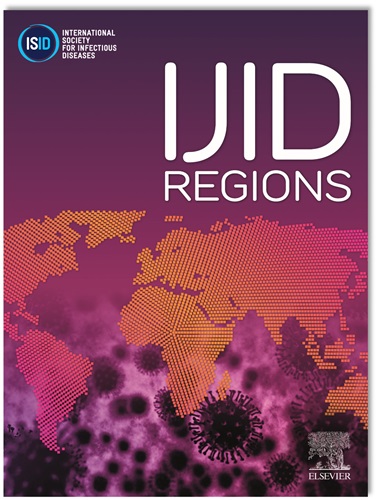Risk factors for persisting SARS-CoV-2 infection in patients with B-cell malignancies in the Omicron era: A multicenter cohort study
IF 4.3
2区 医学
Q1 INFECTIOUS DISEASES
引用次数: 0
Abstract
Objectives
Patients with B-cell malignancies are at high risk of persisting SARS-CoV-2 infection, which may delay oncologic treatments and increase morbidity. We aimed to assess risk factors for persisting infection in this population.
Methods
We conducted a multicenter retrospective study across five tertiary hospitals between January 1, 2022, and January 1, 2023. Adult patients with B-cell malignancies and SARS-CoV-2 infection were included. Persisting infection was defined as viral shedding ≥21 days with clinical and/or radiological signs. Risk factors were evaluated through multivariable logistic regression.
Results
Among 307 patients, 26.1% developed persisting infection. The cohort included non-Hodgkin lymphoma (67.4%), chronic lymphocytic leukemia (19.2%), and Hodgkin lymphoma (9.1%). Independent risk factors included anti-cluster of differentiation 20 therapy (odds ratio [OR], 3.22; 95% confidence interval [CI], 2.37-4.39; P <0.001), and hospital admission at diagnosis (OR, 5.16; 95% CI, 2.37-12.45; P <0.001). Early therapy with nirmatrelvir/ritonavir (OR, 0.32; 95% CI, 0.19-0.54; P <0.001), remdesivir (OR, 0.26; 95% CI, 0.18-0.37; P <0.001), and sotrovimab (OR, 0.32; 95% CI, 0.15-0.67; P = 0.003) were protective. Mortality at 120 days was higher in the persisting group, though not statistically significant (12.5% vs 8.4%; P = 0.277).
Conclusions
Our findings help define risk factors for persisting SARS-CoV-2 infection and support early treatment in patients with B-cell malignancies.
组粒时代b细胞恶性肿瘤患者持续感染SARS-CoV-2的危险因素:一项多中心队列研究
背景:b细胞恶性肿瘤患者持续感染SARS-CoV-2的风险很高,这可能会延迟肿瘤治疗并增加发病率。我们的目的是评估这一人群持续感染的危险因素。方法:我们在2022年1月1日至2023年1月1日期间对五家三级医院进行了多中心回顾性研究。纳入b细胞恶性肿瘤和SARS-CoV-2感染的成年患者。持续感染定义为病毒脱落≥21天,并有临床和/或放射学征象。通过多变量logistic回归评估危险因素。结果:307例患者中,26.1%发生持续性感染。该队列包括非霍奇金淋巴瘤(67.4%)、慢性淋巴细胞白血病(19.2%)和霍奇金淋巴瘤(9.1%)。独立危险因素包括抗cd20治疗(OR 3.22; 95% CI 2.37-4.39)。结论:我们的研究结果有助于确定持续SARS-CoV-2感染的危险因素,支持b细胞恶性肿瘤患者的早期治疗。
本文章由计算机程序翻译,如有差异,请以英文原文为准。
求助全文
约1分钟内获得全文
求助全文
来源期刊
CiteScore
18.90
自引率
2.40%
发文量
1020
审稿时长
30 days
期刊介绍:
International Journal of Infectious Diseases (IJID)
Publisher: International Society for Infectious Diseases
Publication Frequency: Monthly
Type: Peer-reviewed, Open Access
Scope:
Publishes original clinical and laboratory-based research.
Reports clinical trials, reviews, and some case reports.
Focuses on epidemiology, clinical diagnosis, treatment, and control of infectious diseases.
Emphasizes diseases common in under-resourced countries.

 求助内容:
求助内容: 应助结果提醒方式:
应助结果提醒方式:


